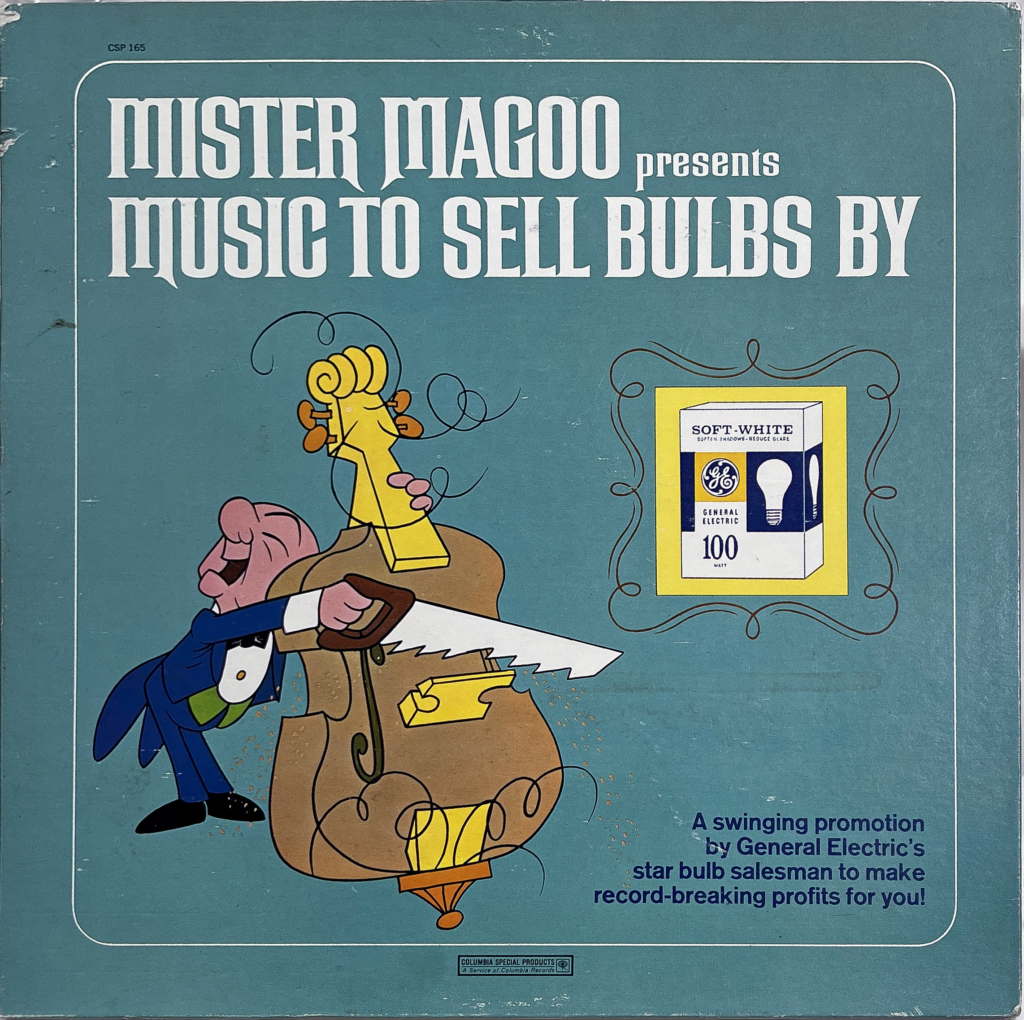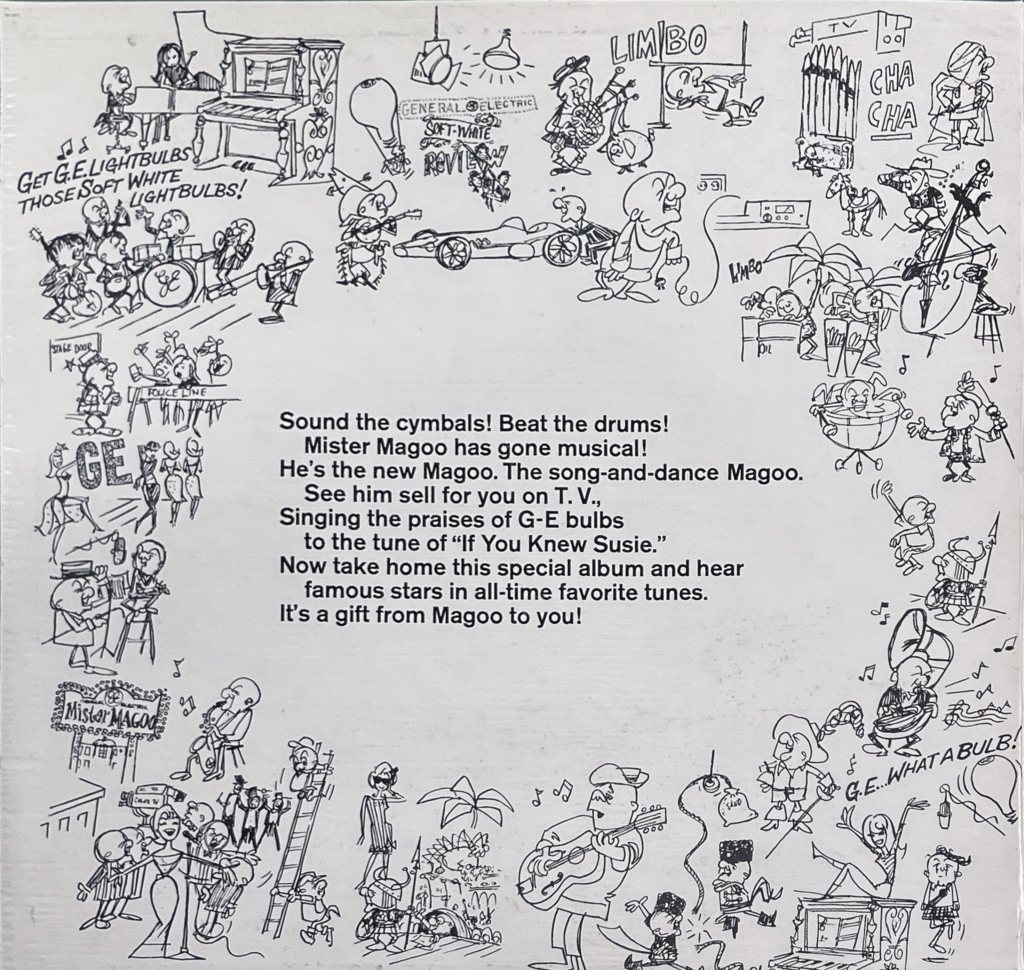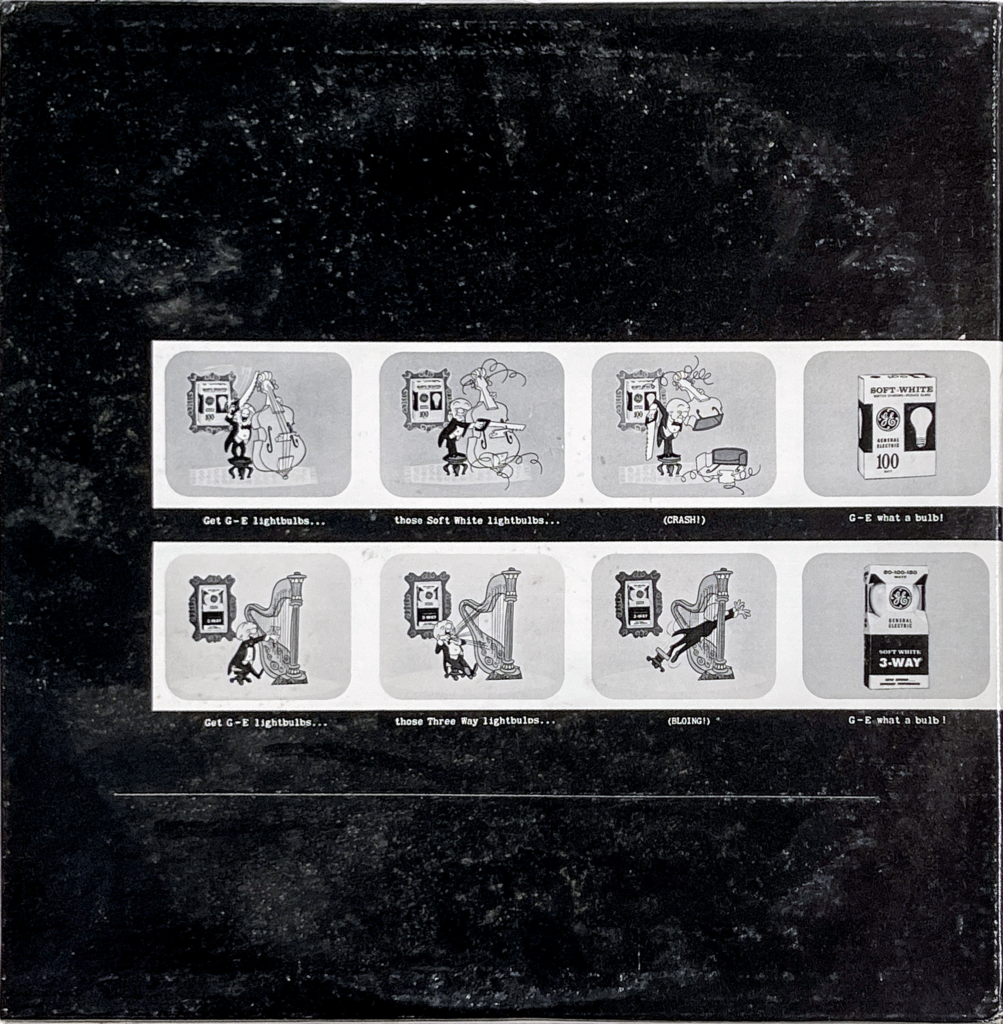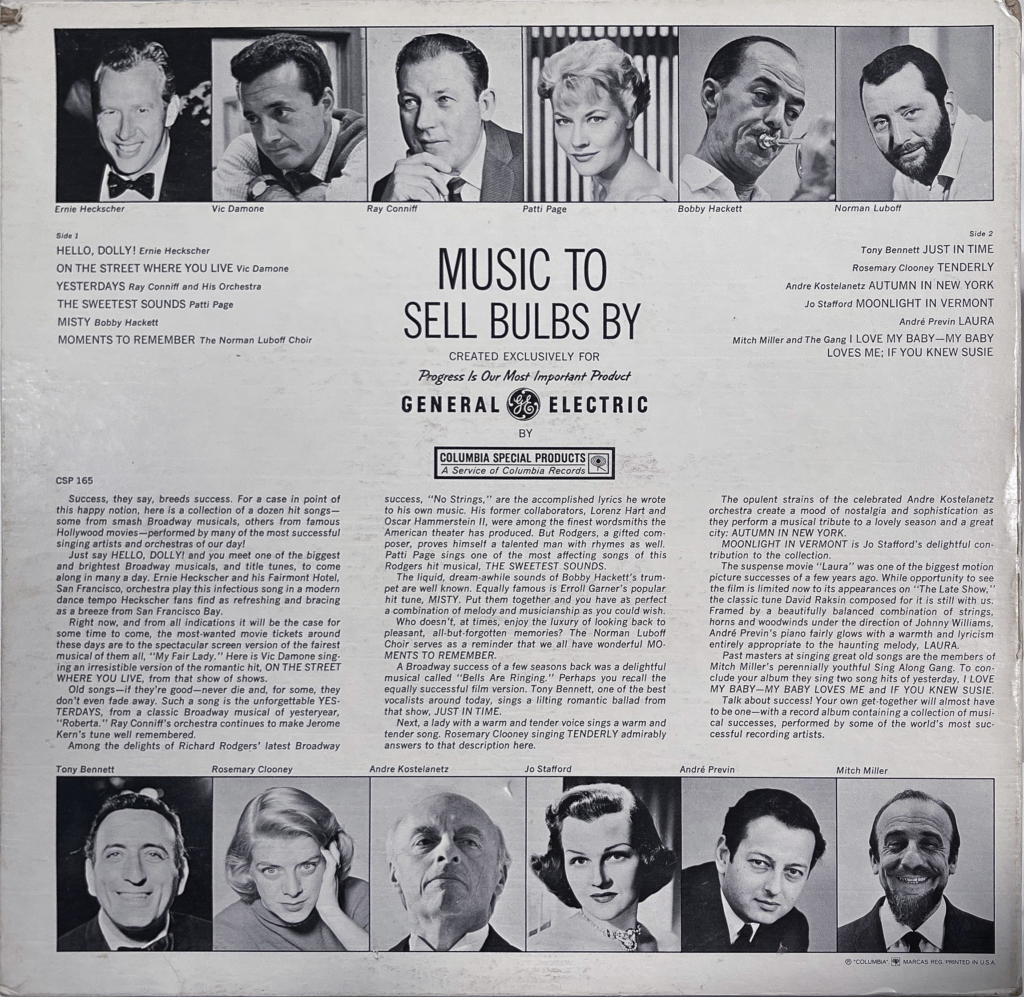Greetings from the deep blue where whimsy meets waves in “Finnley’s Audio Adventures”! Today, we embark on an auditory journey that stretches beyond the ordinary, guided by none other than me, Finnley the Dolphin. Our voyage takes us into the heart of a unique blend of animation and marketing genius, starring the legendary character Mister Magoo and his unexpected role in the evolution of advertising with General Electric’s innovative campaign. As we dive into the tale of “Mister Magoo – Music To Sell Bulbs By,” we’ll explore how this blend of character-driven storytelling and musical enchantment not only entertained but also transformed promotional tactics. So, let your curiosity lead, and prepare to be immersed in a story that showcases the magical intersection of animation, music, and marketing. Welcome aboard Finnley’s Audio Adventures, where every splash tells a story!

Mister Magoo is an iconic animated character who made his debut in the late 1940s. He was created by Millard Kaufman and John Hubley for the UPA (United Productions of America) animation studio, which sought to break away from the traditional animation styles of the time and create more abstract and stylistically innovative cartoons. Mister Magoo quickly became one of the most beloved characters in American animation, known for his distinctive personality and visual style. Mister Magoo’s voice was provided by Jim Backus, a well-known actor with a rich career in radio, television, and film. Backus’ voice work brought to life Magoo’s gruff but endearing personality, contributing significantly to the character’s popularity. Jim Backus also starred as Thurston Howell III on the television series “Gilligan’s Island,” but it was his role as Mister Magoo that cemented his legacy in the realm of animation. Characterized by his severe nearsightedness which he stubbornly refuses to acknowledge, leading to a series of comedic mishaps, Mister Magoo is an elderly, wealthy, short-statured gentleman who navigates the world in blissful ignorance of the chaos his poor vision causes. Despite his challenges, Magoo’s adventures typically end in a fortuitous twist, leaving him unscathed and often better off than before.

The Mister Magoo General Electric (GE) light bulb advertising campaign from the 1960s is notable not only for its creative use of the beloved nearsighted character but also for the unique narrative elements it introduced, including the concept of “bulb snatchers.” In these advertisements, Mister Magoo would often attribute his poor vision and the inadequate lighting in his home to the mischievous actions of imaginary “bulb snatchers,” who he believed were stealing his light bulbs. This humorous premise suggested that to counteract these fictitious thieves and ensure a well-lit home, viewers needed to purchase more GE light bulbs. Adding to the appeal of the campaign, during this period, GE introduced the soft white light bulb, an innovation in home lighting. The soft white bulb was marketed for its ability to produce illumination that had no hot spot and cast no harsh shadows, contrasting sharply with the more direct and sometimes glaring light produced by traditional bulbs. This new product was cleverly incorporated into the Mister Magoo ads, positioning it as the ideal solution for anyone wanting to improve their home lighting quality, even if they didn’t have “bulb snatchers” to worry about.

The integration of the soft white bulb into the Mister Magoo campaign exemplified GE’s knack for combining product innovation with engaging advertising narratives. It underscored the message that GE was not just selling light bulbs but was offering solutions for making homes more comfortable and inviting through better lighting. The innovative integration of the soft white bulb into the Mister Magoo General Electric advertising campaign was just one facet of GE’s creative approach to marketing. They didn’t stop at commercials; they ventured into a unique promotional territory that blended music with their advertising efforts, culminating in the creation of “Mister Magoo – Music To Sell Bulbs By.” This record served as a melodious extension of their campaign, aiming to connect with audiences, mostly dealers, in a different but equally engaging medium a promotional tool, described as a swinging promotion by General Electric’s star bulb salesman aimed at making record-breaking profits. In 1964, a distinctively charming vinyl record titled “Mister Magoo – Music To Sell Bulbs By” was released, serving as a testament to the creative marketing strategies of General Electric. This compilation, a limited edition pressing by Columbia Special Products (CSP 165), featured an array of songs spanning genres like Jazz, Pop, and Classical, all styled in an easy-listening and vocal manner. The album art prominently featured Mister Magoo, further tying it to the beloved character’s adventures and mishaps often caused by his poor eyesight, yet humorously resolved, sometimes with the help of GE’s lighting products.
Interestingly, despite the prominent feature of Mister Magoo on the record sleeve and the album being titled “Mister Magoo – Music To Sell Bulbs By,” Mister Magoo himself does not make an appearance on the record. This aspect of the album might initially seem puzzling for those expecting to hear the beloved character’s voice interwoven with the musical tracks or perhaps introducing the songs in his famously befuddled manner. This absence is a curious creative decision, considering the record’s explicit connection to the character and his advertising campaign for GE light bulbs. The cover art and title set a clear expectation that Mister Magoo’s persona would play a role in the album’s content, not just its marketing. However, the collection of songs stands on its own, featuring a variety of artists and styles without any direct input from the character.
The record boasted an impressive lineup of artists and tracks designed to appeal to a wide audience. Side A kicked off with Ernie Heckscher’s rendition of “Hello, Dolly!” followed by other notable performances such as Vic Damone’s “On The Street Where You Live,” Ray Conniff And His Orchestra’s “Yesterdays,” and Patti Page with “The Sweetest Sounds.” Side B continued to impress with Tony Bennett’s “Just In Time,” Rosemary Clooney’s “Tenderly,” and Jo Stafford’s “Moonlight In Vermont,” among others. The lineup features renditions of classic songs, some closely associated with their original performers, now reimagined by a new set of artists.

- Ernie Heckscher – “Hello, Dolly!”
Originally popularized by Louis Armstrong and famously associated with the Broadway musical of the same name, “Hello, Dolly!”, Ernie Heckscher enlivens this piece with his dynamic and colorful big band flair. Heckscher was a renowned bandleader known for his performances at the Fairmont Hotel in San Francisco, bringing elegance and a touch of class to the American songbook. - Vic Damone – “On The Street Where You Live”
This track from the musical “My Fair Lady,” originally performed by Rex Harrison, receives a romantic rendition from Vic Damone. Known for his smooth baritone voice, Damone was a celebrated crooner of the 20th century, enchanting audiences with his interpretations of American standards. - Ray Conniff and His Orchestra – “Yesterdays”
“Yesterdays,” a song from the 1933 musical “Roberta,” was originally composed by Jerome Kern and Otto Harbach. Ray Conniff’s version adds a lush orchestral arrangement, showcasing his talent for blending vocal harmonies with his orchestra’s instrumental depth. Conniff was famous for creating a unique sound that made him a staple in easy listening music. - Patti Page – “The Sweetest Sounds”
With her rendition of “The Sweetest Sounds” from the musical “No Strings,” Patti Page adds her distinctive voice to the mix. Known as “The Singing Rage,” Page was one of the best-selling female artists of the 1950s, celebrated for her smooth, emotive delivery. - Bobby Hackett – “Misty”
Jazz trumpeter Bobby Hackett lends his signature warm tone to “Misty,” a ballad by Erroll Garner. Hackett’s career spanned several decades, during which he contributed to both the swing and jazz genres, known for his lyrical playing style. - Norman Luboff Choir – “Moments To Remember”
The Norman Luboff Choir was known for its choral arrangements of popular songs, and “Moments To Remember” highlights their harmonic capabilities. Luboff’s choir brought a refined touch to the pop and folk tunes of the day, earning them widespread acclaim. - Tony Bennett – “Just In Time”
“Just In Time,” from the musical “Bells Are Ringing,” is performed by Tony Bennett, whose career has spanned over seven decades. Bennett is a legend in the music industry, known for his classic vocal style and interpretations of jazz standards. - Rosemary Clooney – “Tenderly”
An American singer and actress, Rosemary Clooney brought emotion and depth to every song she touched, including “Tenderly.” Her rich, warm voice made her a beloved figure in pop and jazz music, celebrated for both her ballads and upbeat numbers. - Andre Kostelanetz – “Autumn In New York”
Andre Kostelanetz’s orchestral rendition of “Autumn In New York,” a jazz standard by Vernon Duke, showcases his skill in creating lush, romantic arrangements. Kostelanetz was a pioneer in easy listening music, known for his innovative use of the orchestra. - Jo Stafford – “Moonlight In Vermont”
Jo Stafford’s “Moonlight In Vermont” offers a soothing, velvety vocal interpretation of this jazz standard. Stafford’s pure tone and impeccable diction made her one of the most respected singers of her era, with a career that touched jazz, pop, and classical music. - André Previn – “Laura”
André Previn, a versatile conductor, pianist, and composer, brings his jazz sensibilities to “Laura,” a song from the movie of the same name. Previn’s contributions to both classical and jazz music were immense, blending the two genres seamlessly. - Mitch Miller and The Gang – “I Love My Baby — My Baby Loves Me; If You Knew Susie”
Mitch Miller’s influence on popular music, particularly through his sing-along series, is evident in this medley. Known for his “Sing Along with Mitch” albums and TV show, Miller’s work emphasized communal and accessible music-making.
Each of these artists brought their own unique flavor to “Mister Magoo – Music To Sell Bulbs By,” creating a compilation that transcends the usual boundaries of promotional material to become a cherished piece of musical history. With “Mister Magoo – Music To Sell Bulbs By” serving as a harmonious bridge between entertainment and product promotion, it’s fascinating to pivot from this unique intersection of music and marketing to explore the historical backdrop of General Electric (GE) itself, especially its pioneering contributions to the development and popularization of light bulbs leading up to the 1960s.
General Electric, a company whose roots intertwine with the very fabric of American industrial progress, has been a beacon of innovation and technological advancement. The story of GE’s involvement with light bulbs begins with one of the company’s founding figures, Thomas Alva Edison, whose invention of the incandescent light bulb in 1879 revolutionized the way people illuminated their homes and workplaces. Edison’s invention laid the groundwork for the future of electric lighting, a future that GE would come to dominate.
Formed in 1892 through the merger of Edison General Electric Company (established by Thomas Edison) and Thomson-Houston Electric Company, GE quickly positioned itself as a leader in the burgeoning electrical industry. The company’s early involvement in electric lighting was pivotal, driving advancements that would make electric light accessible and reliable for widespread use. Throughout the early 20th century, GE continued to innovate in the lighting industry, introducing new technologies and improving the efficiency and longevity of light bulbs. This period saw the introduction of tungsten filaments, which offered brighter and more energy-efficient lighting than their carbon filament predecessors. GE’s research and development efforts also led to the creation of gas-filled bulbs, further enhancing efficiency and performance.
By the mid-20th century, GE had firmly established itself as a household name in lighting. The company’s commitment to innovation was underscored by its introduction of fluorescent lighting in the 1930s, offering consumers an alternative to traditional incandescent bulbs that was both longer-lasting and more energy-efficient. This era of innovation set the stage for GE’s continued advancements in lighting technology, including the development of the soft white bulb in the 1960s, an innovation that would become a staple in homes across America. The soft white bulb, with its ability to produce light that was gentle on the eyes while effectively illuminating spaces without harsh shadows or hot spots, was emblematic of GE’s approach to product development: combining technological innovation with an understanding of consumer needs. This period in GE’s history was not just about creating better products but also about shaping the future of how people lived and worked, making everyday life brighter and more efficient.
The evolution from the soft white light bulbs of the 1960s to the modern era’s LED and CFL technologies showcases the relentless pursuit of innovation characteristic of companies like GE. The album “Mister Magoo – Music To Sell Bulbs By” acts as a heartwarming beacon back to a time when incandescent bulbs stood at the forefront of lighting technology, their introduction and appeal amplified by inventive and captivating marketing techniques. This collection, with its diverse musical array and subtle nod to GE’s lighting solutions, encapsulates a period marked by technological enthusiasm and marvel. However, the shift from traditional incandescent bulbs to energy-efficient alternatives signifies more than just an advancement in technology; it marks a significant cultural and environmental evolution. This change embodies our shared strides towards a sustainable existence, underscoring the idea that every innovation, regardless of size, plays a part in fostering a brighter and more eco-friendly future. “Mister Magoo – Music To Sell Bulbs By” stands as a testament to the fusion of creativity and innovation, reminding us that the blend of daily necessities with the timeless charm of familiar narratives and characters can light up our journey ahead.
And so, we conclude another episode of “Finnley’s Audio Adventures” with our fins firmly dipped in the rich history of animation’s crossover into advertising and music. Our journey with Mister Magoo has taken us through a fascinating narrative that highlights the intersection of creativity, character appeal, and marketing innovation. By exploring the collaboration between Mister Magoo and General Electric, we’ve uncovered how storytelling and music can transcend traditional advertising, creating memorable experiences that resonate with audiences across different eras. This adventure serves as a vivid reminder of the enduring power of creativity and its ability to connect, entertain, and enlighten. As we look forward to more audio adventures that delve into the extraordinary, remember that the world of sound is boundless, filled with tales waiting to be heard. Thank you for letting Finnley the Dolphin be your guide through the wondrous sea of audio escapades. Until our next adventure, keep your ears open, stay curious, and never stop exploring the depths of imagination and sound!
Sources:
GE:
https://www.ge.com/about-us
https://www.gelighting.com/about
The New York Times:
https://www.nytimes.com/2017/06/12/business/general-electric-history-of-innovation.html
Britannica:
https://www.britannica.com/topic/General-Electric
Hagley:
https://digital.hagley.org/FILM_2019227_FC116
ALLMUSIC:
https://www.allmusic.com/artist/ernie-heckscher-mn0001542768
https://www.allmusic.com/artist/vic-damone-mn0000205254
https://www.allmusic.com/artist/ray-conniff-mn0000869487
https://www.allmusic.com/artist/patti-page-mn0000747506
https://www.allmusic.com/artist/bobby-hackett-mn0000077698
https://www.allmusic.com/artist/norman-luboff-mn0000885712
https://www.allmusic.com/artist/tony-bennett-mn0000006334
https://www.allmusic.com/artist/rosemary-clooney-mn0000345734
https://www.allmusic.com/artist/andr%C3%A9-kostelanetz-mn0000754767
https://www.allmusic.com/artist/jo-stafford-mn0000112017
https://www.allmusic.com/artist/andr%C3%A9-previn-mn0000030250
https://www.allmusic.com/artist/mitch-miller-mn0000577261
Discogs:
https://www.discogs.com/release/14428472-Mister-Magoo-Music-To-Sell-Bulbs-By
